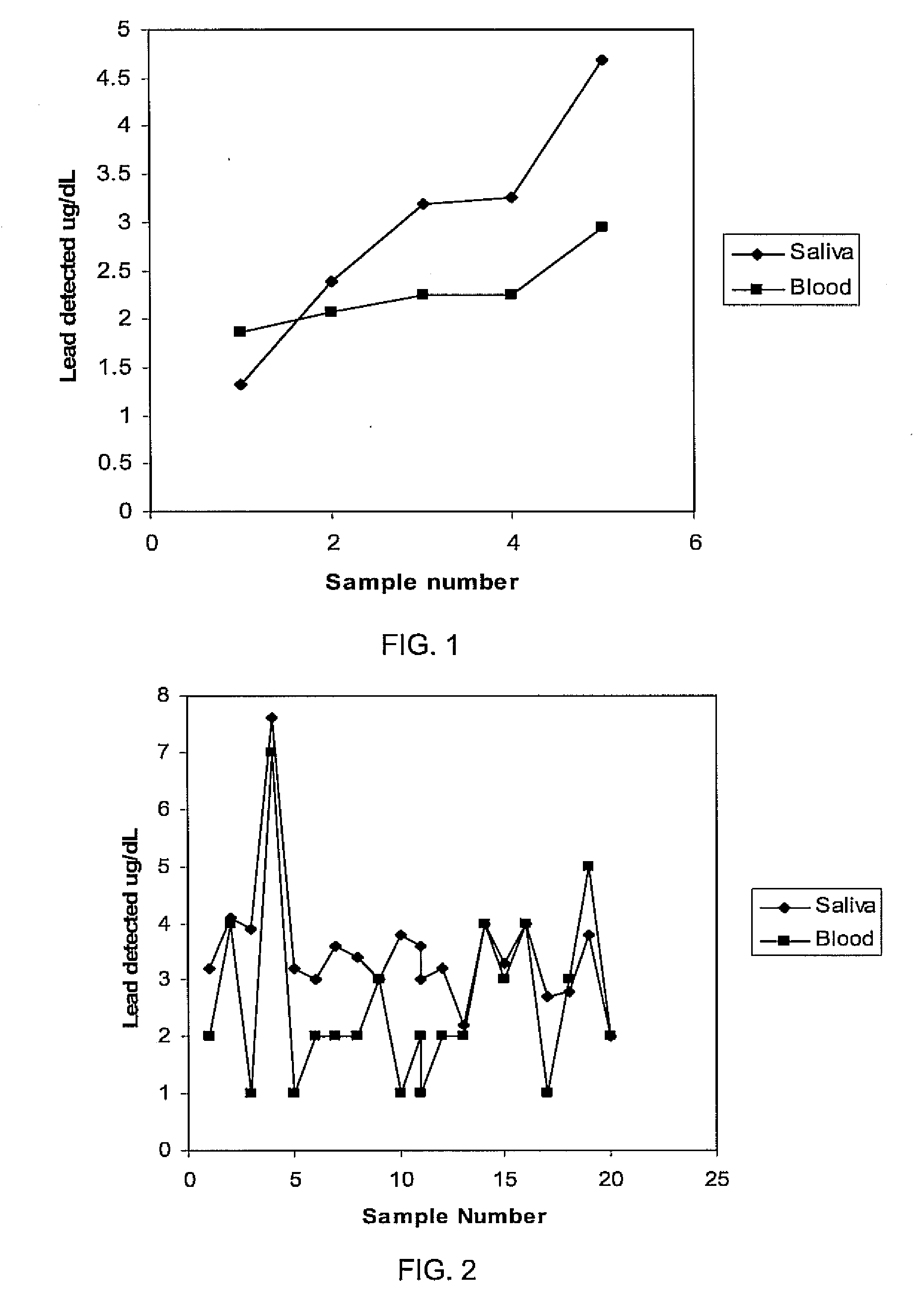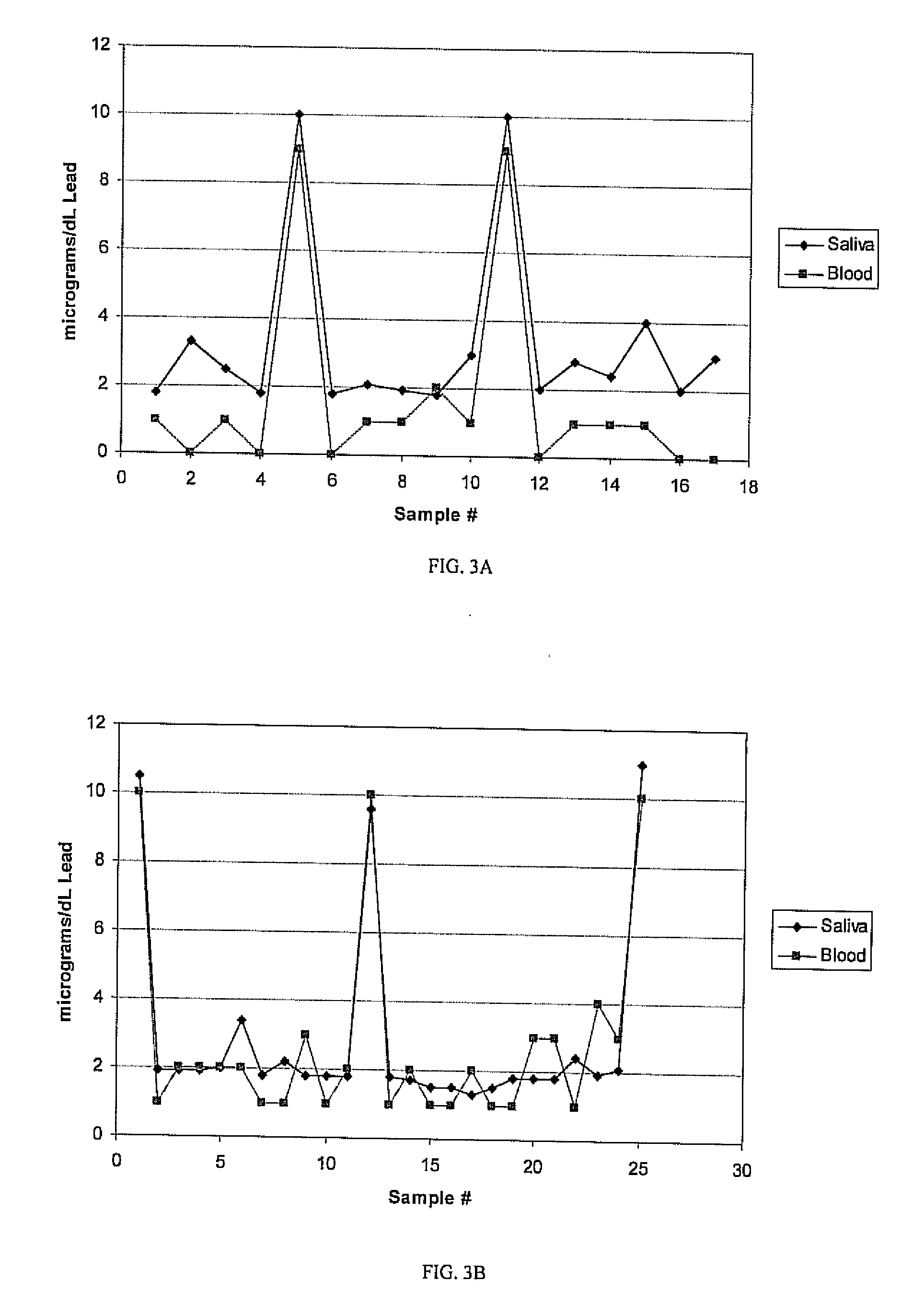Saliva assay technique for heavy metal
a saliva assay and heavy metal technology, applied in the field of non-invasive saliva assay for heavy metal, can solve the problems of only being able to put in place treatment, affecting children's health, and symptomatic of heavy metal poisoning are well known
- Summary
- Abstract
- Description
- Claims
- Application Information
AI Technical Summary
Problems solved by technology
Method used
Image
Examples
example 1
Stock Solutions
[0025]HPLC grade water is purchased from Pharmco and used for up to 12 months after receipt. Each bottle of HPLC grade water when opened is used for only up to 30 days. A 20% nitric acid solution is created by half filling a 1 liter volumetric flask with HPLC grade water and adding 287 ml of 69.7-70% assay trace metals grade nitric acid to the flask and filling to a volume of 1 L. Mass spectrometer wash solvent is provided using HPLC grade water to flush lines.
[0026]Clinical standard lead is purchased from VWR International at 1000 ppm, 100 ug / dl. Linearity standards are prepared at 2, 10, 50, 100, and 500 parts per million (ppm) with volumetric glassware and HPLC grade water. A PerkinElmer ELAN DRCe inductively coupled plasma mass spectrometer is energized and allowed to stabilize for from 60 to 90 minutes. Thereafter, the instrument is prompted to load the lead detection protocol setting appropriate parameters for the lead isotopes 206, 207, and 208. Sample times an...
example 2
Correspondence of Blood and Saliva Lead Levels Derived from Inductively Coupled Plasma Mass Spectrometry
[0031]Twenty-one double-blind sample sets were collected from volunteers. Each sample set included a whole blood sample and a saliva sample. Applying the procedure of Example 1, and accounting for dilution associated with saliva absorption into filter paper used to collect the saliva sample, a blood lead level is plotted directly in FIG. 2 for the 21 blind samples while the blood level derived by correcting for saliva dilution associated with saliva absorbable into a square centimeter of filter paper is provided in FIG. 2.
example 3
Correlation of Blood and Saliva Results Including Dangerous Levels of Lead
[0032]The sampling procedure of Example 1 is repeated with 17 and 25 dual sets of double-blind saliva and whole blood samples. The results measured lead levels corresponding to blood levels are plotted in FIGS. 3A and 3B, respectively, for the 17 and 25 double-blind sample sets with correction being made for the amount of saliva being absorbable into 1 cm2 of filter paper as the saliva collection medium. Based on the high degree of correlation between blood levels detected in blood and saliva, blood levels are estimated from saliva for a group of 39 unknown samples, as shown in FIG. 4.
PUM
 Login to View More
Login to View More Abstract
Description
Claims
Application Information
 Login to View More
Login to View More - R&D
- Intellectual Property
- Life Sciences
- Materials
- Tech Scout
- Unparalleled Data Quality
- Higher Quality Content
- 60% Fewer Hallucinations
Browse by: Latest US Patents, China's latest patents, Technical Efficacy Thesaurus, Application Domain, Technology Topic, Popular Technical Reports.
© 2025 PatSnap. All rights reserved.Legal|Privacy policy|Modern Slavery Act Transparency Statement|Sitemap|About US| Contact US: help@patsnap.com



